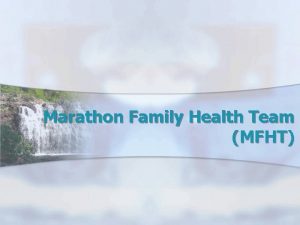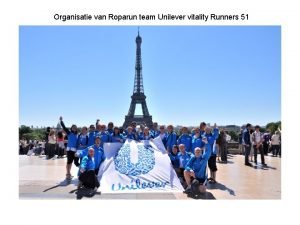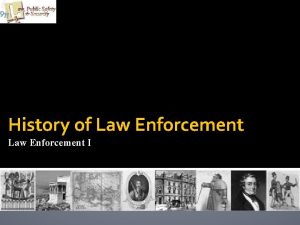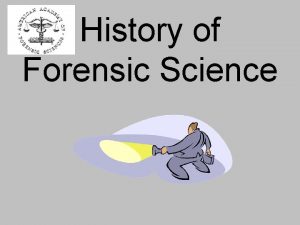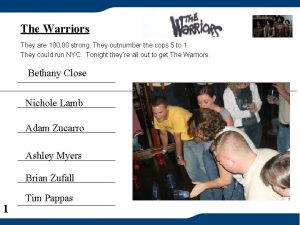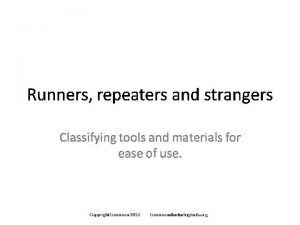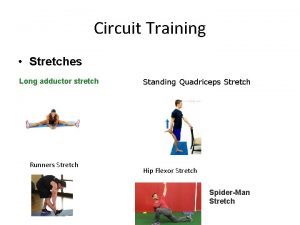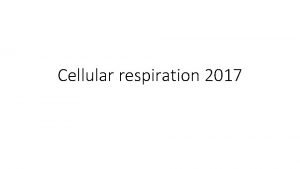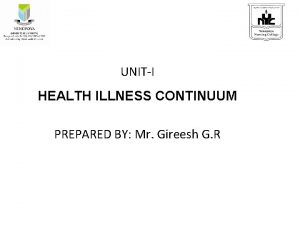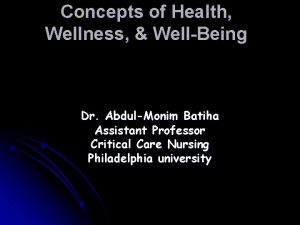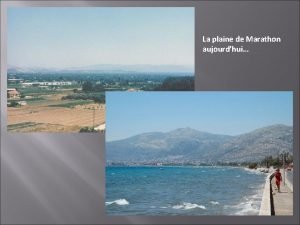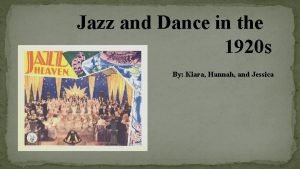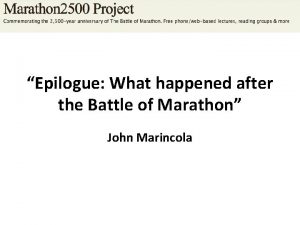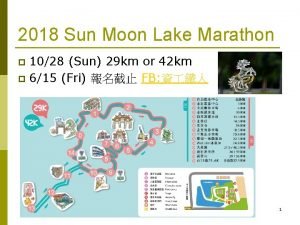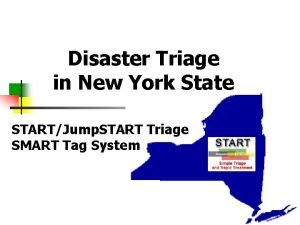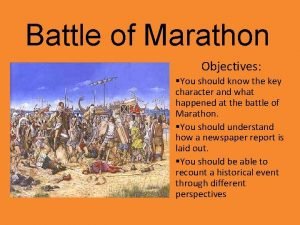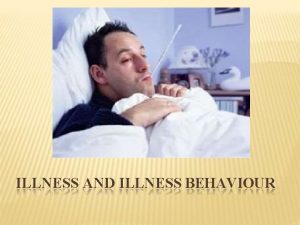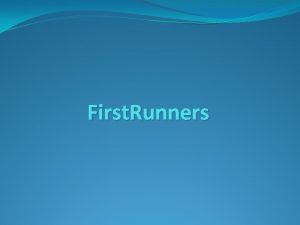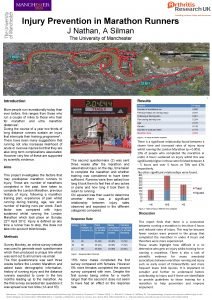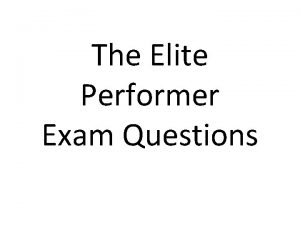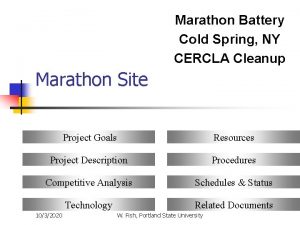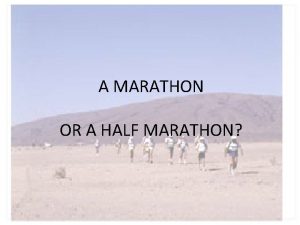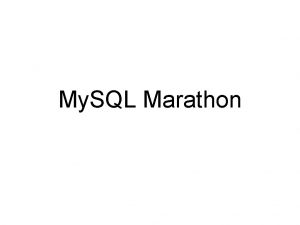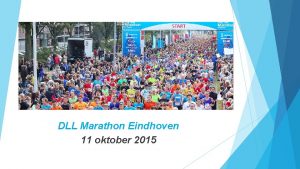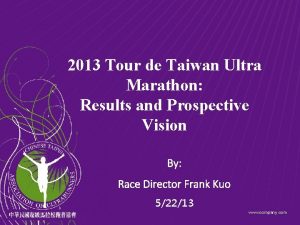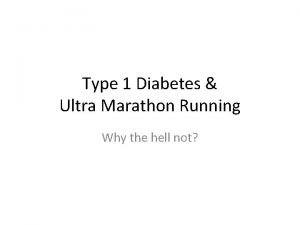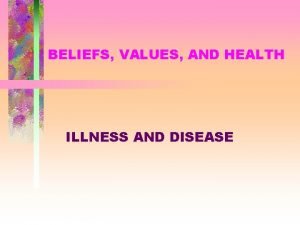Health and Illness Practices of Ultra Marathon Runners






















- Slides: 22

Health and Illness Practices of Ultra Marathon Runners By Chelsea L. Giles HSC 210: Cultural Aspects of Health

Learning Objectives • Learn the history of ultra marathon running • Understand what drives an ultra marathon runner to run ultra marathon distances • Learn the health and training practices of ultra marathon runners

History and Background of Ultra Marathon Running • Ultra marathon running (UMR) began with migration routes between Alaska and the Great Plains. • The original ultra marathon runners were Native Americans. • Men and women could be a tribe runner. • Native Americans could run up to 400 miles continuously! • The primary purpose of running was as a means of communication. • Tribal leaders required the runners to relay information between tribes. • Runners would deliver documents to other tribal leaders. • Runners would warn other tribes of enemy attacks.

History and Background of Ultra Marathon Running • Early European settlers adapted Native American running practices • European settlers introduced the use of the horse and buggy to transport goods and deliver large quantities of goods. • For long distant deliveries runners were still preferred because the horse would collapse but the runners could keep going. • European settlers introduced automobiles. • Automobiles were the downfall of ultra running • Today ultra marathon has transformed from a necessary means of communication into a hobby! • Ultra marathon- any foot race over 26. 2 miles

Meet REAL ULTRA RUNNERS

Say Hello to Steve! Steve was born November 8, 1980 in Las Vegas, Nevada. The city scape was all that Steve ever knew, as the son of owners of a Las Vegas motel. His parents did not have a lot of time to spend with him, so he occupied his time playing alone with the toys his parents bought him. Steve did not have any friends and was constantly made fun of for being overweight. Steve grew up to be tall and lanky, not overweight anymore but unfit. He blended in with the other people along the Las Vegas strip and nothing set him apart from the masses. Working as a single business man for 10 years, Steve wanted to already be operating his own casino. However, the harder he worked the further his goals appeared to be from him. Frustrated with his work and overwhelmed by the pressures of life, Steve needed to escape! Steve wanted something more that set him apart from everyone else in Las Vegas, something that made him different, something greater. So he turned to ultra marathon running!

Ultra Runner’s Definition of Health • Health- one’s ability to push their body to the fullest extent without limitations by the mind, body, or spirit. • A runner considers themselves healthy as long as they can run. • Mental clarity is a key factor in an ultra runner’s health. • “Runner’s High”- a euphoric state when an ultra runner is able to push their body to the fullest extent by sheer mental determination, while simultaneously having a completely clear mind.

Ultra Runner’s Definition of Illness • Illness- anything that prevents an individual from running. • Ultra runners have a high tolerance for pain, not all pain is significant.

Ultra Marathon Diet • All natural plant based diet. • The diet includes: • Fruits and vegetables • Whole Grains (Gluten Free) • Nuts and Seeds • Soy, rice, almond, or coconut milk (Dairy Free) • The diet excludes: • Processed food • Food with artificial ingredients • Gluten • Dairy • Alcohol

Steve’s Diet Requirements Age: 34 Gender: Male Height: 6’ 3” Weight: 150 lbs Activity level: Extremely Active/50 miles per day Basal Metabolic Rate: 1, 721 calories Daily Calorie Needs: 6, 721 calories Daily Calories (max weight loss desired) 3, 400 calories Fluid requirements: 75 fl oz + rehydrating throughout the run Protein requirements: 56 grams

Green Power Smoothie Recipe: 2 bananas 1 cup of mango or pineapple chunks 4 cups of water 2 tsp spirulina powder 1 tsp miso Blend and drink 15 -45 minutes prior to run

Training Program Beginner Training 1. Begin training at 50%-70% of maximum run, while still being able to maintain a conversation 2. Count the number of times your right foot strikes the ground in 20 seconds, then multiple that by 3. The goal is 85 -90 strides that consist of short, light, quick steps. 3. Foot strikes the ground at the forefoot or mid-foot. 4. Run 3 -4 days per week, with substantial rest between each run. Advanced Training 1. Run 5 out of 7 days of the week. 2. Preparation for a 50 mile run = minimum of 250 miles per week 3. Run in all types of weather. 4. Run on the same surface as the race you are preparing for. 5. Cross train on non-running days by completing high intensity interval workouts, agility workouts, plyometric, or moderate weight lifting.

Preventative Care • Stretching before and after exercise. • Allowing a warm up period of about 15 minutes prior to exercising. • Allowing a 15 minute cool down period after exercising • Wearing the appropriate shoes and clothing • Rehydrate connective tissue • Eat a proper diet • Rest • Regularly visit a chiropractor

Healing Practices • Rest • 8 hours of sleep each night • Rehydrating connective tissue • Eating a proper diet • Visiting a Chiropractor • Visiting a physical therapist • Visiting a homeopathic doctor • Visiting a medical doctor • If in need of an x-ray or surgery

Behaviors and Beliefs • Ultra runners can be from any race, gender, background, or religious affiliation. • It is paramount to focus on running, so many ultra runners take a vow of celibacy. • Running is not just a part of an ultra runner’s life it is who they are. • Ultra runners believe they can set themselves apart from average by running ultra marathons. • Many ultra runners are searching for a purpose in this world and they find it in their running.

Health Concerns - Dehydration can lead to heat stroke and death while running. - Sprains, muscle spasms, and torn ligaments These may be from improper foot placement, falls, or overuse injuries - Break down of cartilage in the joints, especially the knees Most ultra runners require knee replacements when they get older - Increased risk of developing arthritis Arthritis is inflammation of the joints that make it difficult to move and sometimes impossible to move the arthritic joint. - Hardening of the arteries, increasing the risk of a cardiovascular event - Hypertrophy of the heart muscle

External Health Concerns 1. The elements: Hot temperature- leads to heat exhaustion and death Sun- second degree burns Wind- wind burn Rain/Ice- increased risk of falling Freezing temperatures- leads to frostbite and amputations 2. Poisonous Plants: Poison Ivy, Poison Oak, Poison Sumac These plants can cause debilitating blistering rashes 3. Animals: Snakes- snake bites (some are lethal) Spiders- spider bites (some are lethal) Bears & mountain lions – attack and kill runners Raccoons, Dogs, Coyotes- attack runners Mosquitoes, bees- cause stings, allergic reactions, and diseases Squirrels- dart out in front of runners causing missteps and injury Alligators- attack runners, biting off lower extremities Skunks- spray with odor that leeches into the skin and can burn the eyes

Cultural Factors • Ultra runners are trying to escape whatever culture they are a part of. • Mainly the fast paced, busy American lifestyle • Ultra running comes with a community of runners that develop into its own culture. • Ultra marathon runners are searching for a purpose in their life and without it they are the same as everyone else, they fear being average and not leaving a mark on the world

Ultra Running Statistics • 1. About 0. 3% of the population has completed an ultra marathon • Men’s record for the fastest 100 mile road race • • Bernd Heinrich (USA) May 19, 1984 – Ottawa Canada Time: 12. 27. 01 Pace: 7 minute, 28 second mile • Women’s record for the fastest 100 mile road race • • Ann Transon (USA) May 4, 1991 – Queens, New York Time: 13. 47. 41 Pace: 8 minute 16 second mile

Competent Care for Ultra Runners 1. Runners need access to a dietitian who specializes in marathon and ultra marathon running diets, in order to properly prepare them for training. 2. Runners need affordable access to physical therapists to maintain joint mobility and prevent injury. 3. Runners need affordable access to chiropractors to restore total body alignment. 4. Members of the healthcare team need to understand that not running, is not an option.

Exam Questions 1. What qualifies a race as an ultra marathon? A. 50 miles B. 100 miles C. Over 26. 2 miles 2. Who were the original ultra marathon runners? A. Early European Settlers B. Native Americans C. 21 st century runners 3. The original decline in the need for ultra runners was due to? A. horses B. automobiles C. It was never a necessity 4. What is the main drive behind ultra marathon runners? A. Escaping their worries and searching for purpose B. Wanting to make an investment in their health C. Enjoys spending time in the outdoors. 5. What is the biggest challenge ultra runners face with the healthcare system? A. Runners are focused on preventative care, the healthcare system is not B. The healthcare system focuses on preventative care, runners do not C. There is not affordable access to holistic doctors and dietitians D. Both A and C are correct

References • I. Milroy A. In the Beginning: Native Americans. Ultra Running Magazine Website. http: //ww. ultrarunning. com/features/destinations/in-the-beginning-native-americans/ Published August 15, 2013. Accessed February 4, 2015. • II. Mc. Dougall P. Born to Run: A Hidden Tribe, Superathletes, and the Greatest Race the World Has Never Seen. New York, NY: Alfred A Knopf; 2009 • III. Jurek S. Eat and Run: My Unlikely Journey to Ultramarathon Greatness. New York, NY: Houghton Mifflin Harcourt Publishing Company; 2012. • IV. Magill P, Schwartz T, Breyer M. Building Your Running Body. New York, NY: The Experiment, LLC; 2014. • V. Long Term Ultra Marathon Running and Arterial Compliance. US National Library of Medicine Website. http: //www. publicmedicine. gov. May 17, 2014. Accessed February 5, 2015. • VI. Quinn E. Checklist for Running Overuse Injuries. Sports Medicine Website. http: //www. sportsmedicine. about. com/od/runninginjuries/a/runners_overuse. htm • December 15, 2014. Accessed February 6, 2015. • VII. Beni Amy. Ultra Marathon Runner, oral communication, February 2015. • VIII. Simmons, Lee. Enlarged Heart and Running. Live. Strong. . com <http: www. livestrong. com/article/310153 -enlarged-heart-running> November 17, 2010. Accessed February 14, 2015 IX. Campbell, Lynn. Registered Dietitian, oral communication, February 2015. X. Bing Images. http: //www. bing. com/images. Accessed Febrauary 15, 2015. XI. Ultramarathon Running Resources. Ultramarathon. Running. com. http: //www. ultramarathonrunning. com/recods 12/1/2014. Accesses February 15, 2015.
 Marathon health clinic
Marathon health clinic Mental health and mental illness chapter 20
Mental health and mental illness chapter 20 Vitality runners
Vitality runners Bow street runners definition
Bow street runners definition Bow street runners definition
Bow street runners definition Moonrunners the warriors
Moonrunners the warriors Pronto hot runners
Pronto hot runners Runners repeaters strangers
Runners repeaters strangers Adductor stretches for runners
Adductor stretches for runners Why do runners breathe heavily after a sprint race
Why do runners breathe heavily after a sprint race Conclusion of mental health
Conclusion of mental health Health illness continuum
Health illness continuum Mental health jeopardy
Mental health jeopardy Continuum of health
Continuum of health Plaine de marathon
Plaine de marathon Alma cummings dance marathon
Alma cummings dance marathon The battle of marathon
The battle of marathon Sun moon lake marathon
Sun moon lake marathon Essprotokoll app
Essprotokoll app New balance positioning statement
New balance positioning statement Kati mori london marathon
Kati mori london marathon Disaster triage tag system
Disaster triage tag system Marathon objectives
Marathon objectives
